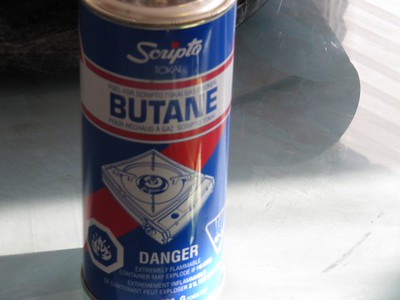
Butane, a commonly used and easily accessible gas, is often found in lighters, portable stoves, and various aerosol products.
Despite its frequent presence in our daily lives, many of us may be unaware of the potential risks associated with butane exposure. It’s essential to understand the possible hazards, particularly when handling the gas, and to take the necessary precautions to ensure our safety.
In this guide, we will explore the properties of butane, the dangers of touching it, how to handle it safely, and what to do if you accidentally come into contact with the substance.
By the end of this article, you’ll have a deeper understanding of butane and feel more confident in handling it safely.
Here’s an article about How is Butane Harmful to Human.
Physical Properties of Butane
To better understand the risks associated with touching butane, it’s essential to know its physical properties. Butane is a hydrocarbon, made up of carbon and hydrogen atoms, and belongs to the alkane family. It is a colorless and odorless gas at room temperature and standard atmospheric pressure.
The primary characteristics of butane that make it potentially dangerous are its flammability and volatility. These properties make butane an excellent fuel source, but they also pose risks when not handled properly.
Hazards of Touching Butane
While butane’s gaseous state might lead you to believe that skin contact is not a concern, the reality is more complex. When butane is released from a container, it rapidly expands and cools, which can cause cold burns or frostbite on the skin.
This effect is similar to what happens when you come into contact with dry ice or a liquid nitrogen spill. Furthermore, if butane comes into contact with your skin in liquid form, it can cause irritation or even chemical burns due to its low temperature.
Butane exposure isn’t only dangerous to your skin. If it comes into contact with your eyes, it can cause severe irritation or even damage to the delicate tissues. The cooling effect of the gas, combined with its potential to cause chemical burns, makes it crucial to avoid contact with your eyes.
In addition to the risks of skin and eye contact, inhaling butane can also be hazardous. When you breathe in the gas, it displaces the oxygen in your lungs and bloodstream, leading to respiratory issues and a lack of oxygen in the body.
This can cause symptoms such as dizziness, confusion, and loss of consciousness. In severe cases, butane inhalation may even be fatal. Additionally, inhaling butane can have a direct impact on the central nervous system, leading to temporary or permanent neurological damage.
| Items | Price |
|---|---|
 |
|
    |
|
    |
Proper Handling of Butane
Given the risks associated with butane exposure, it’s crucial to handle the gas safely and responsibly. When working with butane, always wear appropriate protective gear, such as gloves and goggles. These will help prevent direct contact with the skin and eyes, reducing the risk of cold burns, irritation, and other injuries.
Ensure that the gloves you use are made of a material resistant to butane, such as nitrile or neoprene, as regular household gloves might not provide sufficient protection.
Proper ventilation is also critical when working with butane. The gas is heavier than air, meaning it can accumulate in low-lying areas and create a potentially explosive atmosphere. To prevent this, make sure you use butane in a well-ventilated area, preferably outdoors, and avoid using it near open flames or sparks.
Storage and disposal of butane containers are equally important. Keep butane canisters in a cool, dry place away from heat sources, and avoid exposing them to direct sunlight or extreme temperatures.
When disposing of empty butane canisters, follow the local regulations and guidelines for hazardous waste disposal. This will help protect the environment and ensure the safety of those handling the waste.
What to Do in Case of Accidental Butane Exposure
In the event of accidental butane exposure, it’s essential to know the appropriate first aid measures. If butane comes into contact with your skin, immediately submerge the affected area in cool water to help alleviate the cold burn or frostbite. Do not use ice or extremely cold water, as this can exacerbate the injury.
Remove any contaminated clothing or jewelry and continue rinsing the area with cool water for at least 15 minutes. If irritation or pain persists, seek medical attention.
In case of eye exposure, immediately flush the affected eye with cool, clean water for at least 15 minutes. Hold the eyelids open to ensure the water reaches the entire eye surface. It is crucial to seek medical attention as soon as possible, as eye injuries can be severe and require professional care.
If you have inhaled butane, move to a well-ventilated area with fresh air. If you experience difficulty breathing, dizziness, or loss of consciousness, seek medical help immediately. In some cases, oxygen therapy may be necessary to counteract the effects of butane inhalation.
Comparing Butane to Other Flammable Gases
Understanding the risks associated with butane is easier when comparing it to other flammable gases, such as propane, methane, and ethane. While each gas has its unique properties, they all share certain characteristics, such as being colorless, odorless, and highly flammable.
The primary differences between these gases lie in their energy content, boiling points, and applications. Propane, for example, has a lower boiling point than butane and is commonly used in outdoor grills and heating systems.
Methane is the primary component of natural gas and has a higher energy content than butane, while ethane is primarily used as a feedstock in the petrochemical industry. Regardless of the gas you are working with, it’s essential to understand its specific properties and potential hazards to ensure safe handling.
Is Butane Toxic to Skin
Butane itself is not toxic to the skin, but it can still cause harm if it comes into contact with your skin. When butane is released from a container, it rapidly expands and cools, which can cause cold burns or frostbite due to its low temperature.
This effect is similar to what happens when you come into contact with dry ice or a liquid nitrogen spill. In addition, if butane comes into contact with your skin in its liquid form, it can cause irritation or even chemical burns.
It’s important to handle butane safely and responsibly to avoid these potential hazards. Always wear appropriate protective gear, such as gloves made of a material resistant to butane (like nitrile or neoprene), when working with the gas to minimize the risk of skin injuries.
What to do if you get butane on your skin?
If you accidentally get butane on your skin, follow these steps to minimize the risk of injury:
- Move away from the source of butane to prevent further exposure.
- Immediately submerge the affected area in cool water to help alleviate the cold burn or frostbite. Do not use ice or extremely cold water, as this can exacerbate the injury.
- Remove any contaminated clothing or jewelry from the affected area.
- Continue rinsing the affected area with cool water for at least 15 minutes to help flush away the butane and reduce skin irritation.
- After rinsing, gently dry the area with a clean towel. Avoid rubbing the skin, as this can worsen the injury.
- If irritation or pain persists, seek medical attention. A healthcare professional may recommend further treatment, such as pain relievers or burn creams, depending on the severity of the injury.
Remember that prevention is the best approach when working with butane. Always wear appropriate protective gear, such as gloves made of a material resistant to butane (like nitrile or neoprene), and ensure proper ventilation when using butane to minimize the risk of skin injuries.
Conclusion
In conclusion, touching butane can indeed be hazardous due to its potential to cause cold burns, irritation, and respiratory issues. To minimize the risks associated with butane exposure, it’s essential to handle the gas with caution, wear appropriate protective gear, and ensure proper ventilation when using it.
By educating yourself on the dangers of butane and other flammable gases, you can make informed decisions and prioritize safety in all aspects of your life.
We hope that this detailed and comprehensive guide has provided you with valuable information on the hazards of touching butane and the necessary precautions to take. Stay curious, stay safe, and always remember the importance of handling flammable gases responsibly.


Mike is an experienced propane technician with over 15 years of professional experience in the field. He has dedicated his career to helping customers with their propane needs, from installation to maintenance and repair. Together with Jeremy, he co-founded this website to provide useful information and guidance to customers seeking reliable propane services.






